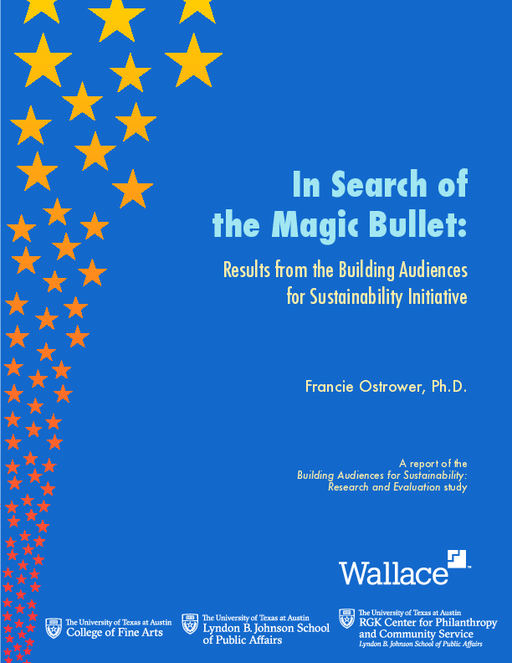- Author(s)
- Francie Ostrower, Ph.D.
- Publisher(s)
- The University of Texas at Austin
Research Approach
Using multiple methods and data sources, BAS researchers conducted three major data collection efforts between 2015 and 2022. A detailed appendix describes key characteristics of the data sources, data collection processes, data cleaning procedures, and survey weight construction.
The three major data collection efforts include:
- Three rounds of in-depth personal interviews with leaders and staff of the 25 participating BAS organizations between 2015 and 2022. In these 301 interviews, researchers explored how participants implemented their projects, their perspectives and experiences, and the relationship between audience-building efforts and broader organizational goals, values, and mission. Interviewees were assured that interviews were confidential, that the research was separate from grant monitoring or reporting, and that individual interview results would not be shared with the foundation.
Two additional data collection efforts (2018-2021) obtained quantitative data from a subset of 15 BAS organizations to independently assess outcomes: whether audience gains were realized and to explore the financial implications of audience-building efforts. This “outcomes study” is included as a subset of 15 BAS organizations. The two types of quantitative data collected were:
- Data from Organizational Ticketing Databases. Researchers compiled information from ticket databases to analyze changes in organizations’ total attendance and ticket revenue between 2015 and 2019; changes in (non-demographic) target-audience attendance between 2015 and 2019; ticket purchasing behaviors; and to draw samples of audience members for a short survey. These data yielded a rich and large source of data, however, the technical challenges were substantial. More of this process is described in the appendix of the report.
- Data from online surveys administered to samples of 2015 and 2019 audiences. The short survey collected information on audience demographics, as well as frequency of, and reasons for, arts attendance. For each organization, there were two sets of survey data, one from the 2015 “pre” season and one from the 2019 “post” period. Survey data were used to assess changes in target-audience attendance for those with demographically defined target audiences. Researchers drew on survey data for other analyses (e.g., to explore the relationship between age and proclivity to attend new works). In all, the survey includes 9,563 respondents who attended performances in 2015, and 10,913 who attended in 2019.
Arts organizations may find the discussion of the challenges and opportunities of using ticket databases as a data source relevant to their own efforts.
Since the research team had interview data for all twenty-five organizations but outcomes data only for a subset of fifteen organizations, report findings and data are separated accordingly.
Researchers used interview data to consider project implementation, organizational perspectives, and experiences with different audience-building strategies among all twenty-five organizations. They then turned to the survey and ticket database data to examine audience and financial changes between 2015 and 2019 for the subgroup of fifteen. To help understand the quantitative patterns, they also draw on qualitative data for those fifteen organizations. These data enabled the study to address the little-researched relationship between audience building and financial health in the nonprofit performing arts.
This report brings together the quantitative and qualitative data, follows organizational project evolution over time, and compares this large number of case studies as appropriate. As rich and varied as the data sources are, the researchers caution that its limitations should also be kept in mind. The design of the initiative, whose grantees constitute our “sample,” did not easily lend itself to determining causal connections. There was no comparison group, organizations generally employed numerous and overlapping strategies, changed strategies (and, in some cases, target audiences), and too few organizational cases were available for some comparisons (e.g., when an organization pursued a unique target audience).






